
The Golden Gate is a strait on the west coast of North America that connects San Francisco Bay to the Pacific Ocean. It is defined by the headlands of the San Francisco Peninsula and the Marin Peninsula, and, since 1937, has been spanned by the Golden Gate Bridge. The entire shoreline and adjacent waters throughout the strait are managed by the Golden Gate National Recreation Area.
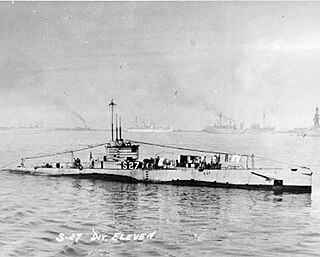
USS S-27 (SS-132) was a S-class submarine of the United States Navy.
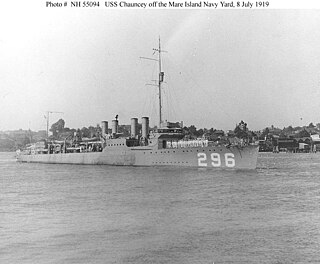
USS Chauncey (DD-296) was a Clemson-class destroyer (ship) built for the United States Navy during World War I.

The Port of Oakland is a major container ship facility located in Oakland, California, in the San Francisco Bay. It was the first major port on the Pacific Coast of the United States to build terminals for container ships. As of 2011 it was the fifth busiest container port in the United States, behind Long Beach, Los Angeles, Newark, and Savannah. Development of an intermodal container handling system in 2002 after over a decade of planning and construction positions the Port of Oakland for further expansion of the West Coast freight market share. In 2019 it ranked 8th in the United States in the category of containers.

The maritime history of California can be divided into several periods: the Native American period; European exploration period from 1542 to 1769; the Spanish colonial period, 1769 to 1821; the Mexican period, 1821 to 1847; and United States statehood period, which continues to the present day. In the history of the California coast, the use of ships and the Pacific Ocean has historically included water craft, fisheries, shipbuilding, Gold Rush shipping, ports, shipwrecks, naval ships and installations, and lighthouses.

The Port of San Francisco is a semi-independent organization that oversees the port facilities at San Francisco, California, United States. It is run by a five-member commission, appointed by the Mayor and approved by the Board of Supervisors. The Port is responsible for managing the larger waterfront area that extends from the anchorage of the Golden Gate Bridge, along the Marina district, all the way around the north and east shores of the city of San Francisco including Fisherman's Wharf and the Embarcadero, and southward to the city line just beyond Candlestick Point. In 1968 the State of California, via the California State Lands Commission for the State-operated San Francisco Port Authority, transferred its responsibilities for the Harbor of San Francisco waterfront to the City and County of San Francisco / San Francisco Harbor Commission through the Burton Act AB2649. All eligible State port authority employees had the option to become employees of the City and County of San Francisco to maintain consistent operation of the Port of San Francisco.

SS Winfield Scott was a sidewheel steamer that transported passengers and cargo between San Francisco, California and Panama in the early 1850s, during the California Gold Rush. After entering a heavy fog off the coast of Southern California on the evening of December 1, 1853, the ship crashed into Middle Anacapa Island. All 450 passengers and crew survived, but the ship was lost.

The SS City of Rio de Janeiro was an iron-hulled steam-powered passenger ship, launched in 1878, which sailed between San Francisco and various Asian Pacific ports. On 22 February 1901, the vessel sank after striking a submerged reef at the entry to San Francisco Bay while inward bound from Hong Kong. Of the approximately 220 passengers and crew on board, fewer than 85 people survived the sinking, while 135 others were killed in the catastrophe. The wreck lies in 287 feet (87 m) of water just off the Golden Gate and is listed in the National Register of Historic Places as nationally significant.
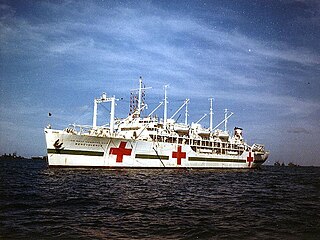
USS Benevolence (AH-13) a United States Navy Hospital Ship, was built as SS Marine Lion in 1944 by Sun Shipbuilding & Drydock Co., in Chester, Pennsylvania, under a Maritime Commission contract. She displaced 11,141 tons fully loaded, was 520 feet (160 m) long, had a beam of 71.6 feet (21.8 m) and a draft 24 feet (7.3 m). Her maximum speed was 17.5 knots. She was sponsored by Mrs. Daisy Unter, transferred to the United States Navy on 31 July 1944, converted to a hospital ship by Todd-Erie Basin Shipyard, Inc., Brooklyn and was commissioned on 12 May 1945.
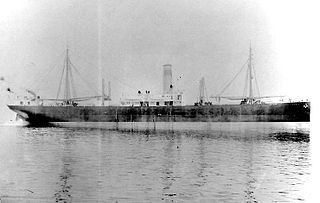
SS Ohioan was a cargo ship built in 1914 for the American-Hawaiian Steamship Company. During World War I, she was taken over by the United States Navy and commissioned as USS Ohioan (ID-3280).
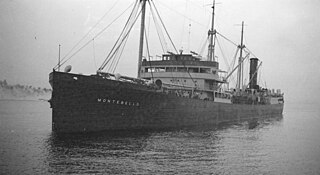
Montebello was a steam oil tanker built in 1920–1921 by the Southwestern Shipbuilding Co. of San Pedro for Union Oil Company with the intention of carrying oil and petroleum products along the West Coast of the United States and Canada as well as between the United States and Chile. In December 1941 the tanker was sunk on one of her regular trips by the Japanese submarine I-21.
Carrier Pigeon was an American clipper ship that was launched in the fall of 1852 from Bath, Maine. Her value was estimated at US$54,000. She was wrecked on her maiden voyage off the north coast of what was then Santa Cruz County in the state of California.

King Philip was a 19th-century clipper ship launched in 1856 and wrecked in 1878. The wreck of this ship is only rarely visible; very infrequently the timbers can be seen protruding from the sands of Ocean Beach, on the Pacific Ocean coast of San Francisco, California. The wreck is the "most complete remains of an American medium clipper." This is a shipwreck of one of many ships that were wrecked in and around San Francisco Bay.
Many ships have wrecked in and around San Francisco Bay. For centuries San Francisco Bay, with its strong currents, rocky reefs, and low fog conditions has experienced more than a hundred shipwrecks. Ever since San Francisco Bay was discovered during the land expedition of Gaspar de Portolà in 1769, it has been one of the most popular harbors.

The SS City of Chester was a steamship built in 1875 that sank after a collision in a dense fog with SS Oceanic at the Golden Gate in San Francisco Bay on August 22, 1888. She was owned by the Oregon Railroad Co. and leased by the Pacific Coast Steamship Company.

Methven Castle was a steam iron passenger cargo ship built in 1882–1883 by Barclay, Curle & Company of Glasgow for Donald Currie & Co. with intention of serving as cargo, passenger and mail carrier on their existing route from England to South Africa. The vessel was later sold to the North American Mail Steamship Co. of Tacoma to work on their Oriental trade routes and renamed Columbia. In 1899 the ship was chartered by the United States Army to transport troops and supplies to various overseas destinations. In 1900 the Army bought out the ship placing it in service as the United States Army Transport Rosecrans but sold it two years later to Matson Navigation Company. The vessel was then converted into an oil tanker to carry oil from the West Coast to Alaska and Hawaii. Subsequently she was sold in 1905 to Associated Oil Co. to carry oil from California to various ports along the Pacific Northwest and Hawaii. In January 1913 while on one of her regular trips, the ship was wrecked off the mouth of the Columbia River with the loss of almost her entire crew.
West Niger was a steam cargo ship built in 1919–1920 by Southwestern Shipbuilding Company of San Pedro for the United States Shipping Board (USSB) as part of the wartime shipbuilding program of the Emergency Fleet Corporation (EFC) to restore the nation's Merchant Marine. The freighter spent her entire career in the Pacific connecting the West Coast of the United States with the Chinese and Japanese ports in the Far East. Early in 1928, the ship, together with ten other vessels, was sold by the Shipping Board to the States Steamship Co. and subsequently renamed Nevada. In September 1932, the vessel, while on her regular trip to Japan, ran aground in foggy weather on Amatignak Island and subsequently broke into three parts and sank with the loss of thirty four out of thirty seven men.
Lyman Stewart was a steam tanker built in 1914 by Union Iron Works Company of San Francisco for the Union Oil Company of California, with intention of transporting oil and petroleum products to ports along the West Coast of the United States and Canada. The ship was named after Lyman Stewart, the president of the Union Oil Co. In October 1922 the tanker collided with another steamer, SS Walter Luckenbach, and was beached to avoid sinking but was subsequently declared a total loss.
The J. A. Chanslor was an oil tanker built in 1910 which was wrecked off of Cape Blanco, Oregon, on 18 December 1919, with only three survivors of the 38 crew.
Davanger was a steam cargo ship built in 1915–1916 by the Union Iron Works of San Francisco for James Rolph, Jr. While under construction, the ship was sold three times, eventually being acquired by Westfal-Larsen of Bergen to be used in tramp trade. The vessel operated between the East Coast of the United States and Europe during her short career and was sunk on her third trip in March 1917 by the German submarine UB-27.














